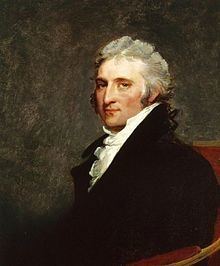Preceded by John Bird Name John Van | Spouse(s) Marcia Burns | |
 | ||
Full Name Johannes Petrus Van Ness Role Former United States Representative Died March 7, 1846, Washington, D.C., United States Education Columbia College of Columbia University in the City of New York Previous office Representative (NY 6th District) 1801–1803 | ||
Political party Democratic-Republican | ||
John Peter Van Ness or Johannes Petrus Van Ness (November 4, 1769 – March 7, 1846) was an American politician who was a United States Representative from New York and who served as the tenth Mayor of Washington DC.
Contents
Early life
Van Ness was born in Ghent, New York on November 4, 1769. He was the son of Elbertje Hogeboom (1743–1806) and Judge Peter Van Ness (1734–1804) and was a member of an old Dutch family. He was the older brother of William P. Van Ness (1778–1826), a federal judge, and Cornelius P. Van Ness (1782–1852), an Ambassador to Spain and Governor of Vermont.
He completed preparatory studies at Washington Seminary and attended Columbia College in New York City. He studied law and was admitted to the bar, but never practiced.
Career
Van Ness was elected as a Democratic-Republican to New York's 6th congressional district for the 7th United States Congress to fill the vacancy caused by the resignation of John Bird and took his seat on October 6, 1801. In April 1802, he was defeated for re-election by Federalist Henry W. Livingston.
On January 17, 1803, Van Ness's seat was declared vacant, because in 1802 he had been appointed by President Thomas Jefferson a major of militia in the District of Columbia, and under the U.S. Constitution no member of Congress could hold any federal office. He then made Washington his home and was president of the second council in 1803. He was promoted to the rank of lieutenant colonel commandant of the first legion of militia in 1805, brigadier general in 1811, and major general in 1813.
During the 1820s, Van Ness was a member of the prestigious society, Columbian Institute for the Promotion of Arts and Sciences, who counted among their members former presidents Andrew Jackson and John Quincy Adams and many prominent men of the day, including well-known representatives of the military, government service, medical and other professions. He was a friend of Washington Irving.
In 1829, he was an alderman of the city of Washington and from 1830 to 1834, Van Ness was the mayor of Washington, D.C.
Van Ness was second vice president of the Washington National Monument Society in 1833 and was president of the commissioners of the Washington City Canal in 1834, and president of the branch bank of the United States at Washington, D.C.; he was also president of the National Metropolitan Bank from 1814 until his death 1846.
Founding of the Washington Jockey Club
In 1802, the Washington Jockey Club sought a new sight for the track that lay the rear of what is now the site of Decatur House at H Street and Jackson Place, crossing Seventeenth Street and Pennsylvania Avenue to Twentieth Street-today the Eisenhower Executive Office Building. Van Ness, along with John Tayloe III and Charles Carnan Ridgely and the support of Dr. William Thornton, G. W. P. Custis, John D. Threlkeld of Georgetown, and George Calvert f Riversdale, the contests were moved to Meridian Hill, south of Columbia Road between Fourteenth and Sixteenth Streets, and were conducted at the Holmstead Farm's one mile oval track.
Personal life
In 1802, Van Ness married Marcia Burns (1782–1832), the daughter of David Burnes (1739–1800) and M. Anne (née Wightt) (1740–1807). She was a prominent philanthropist herself, and supporter of the orphan asylum. Together, they were the parents of:
The couple lived at the Van Ness House, constructed in 1813 to 1816, located at Constitution Avenue and 17th Street, and 18th Street, N.W. It was demolished for the Pan American Union Building.
Van Ness died on March 7, 1846 and was entombed in the Van Ness Mausoleum, which originally stood on H Street, N.W., between Ninth and Tenth Streets in Washington, D.C. His wife who had died September 9, 1832, was also entombed there. In 1872, the mausoleum and the Van Ness remains were moved to Oak Hill Cemetery in Georgetown.
Philanthropy
Although not a Catholic, Van Ness donated the land on which the cornerstone of St. Mary Mother of God church, at the southeast corner of Fifth Street and H Street, N.W. would be laid on March 25, 1846. The land donation was made with the stipulations that Catholic worship should begin there within one year, ensuring the completion of the church on October 18, 1846, and that worship be regularly continued there. If Catholic worship were to ever cease at the location, the land would to revert to the Van Ness family. A new building was constructed in 1890, and the site continues to be the home of St. Mary Mother of God church.
